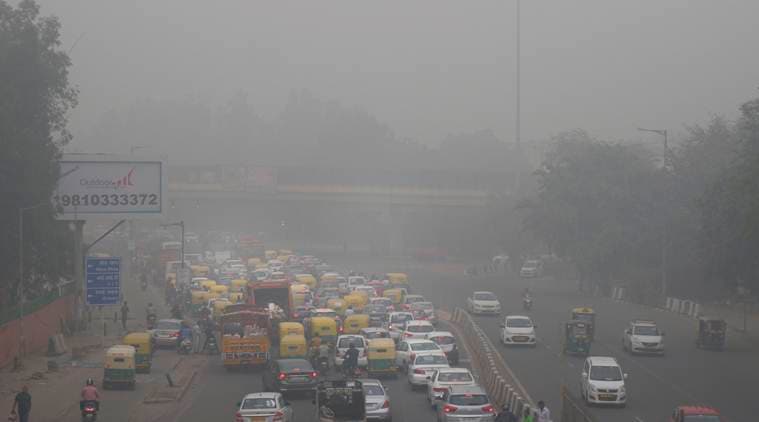This November had the highest average minimum temperature, 15 degrees Celsius, in the last nine years, as per data from the IMD. The normal value is 12.9 degrees Celsius. The city, however, received lower than normal rain fall this time, 1.1 mm, as opposed to a normal of 5.6 mm.
Though the average air quality index (AQI) for the month stood at 312, in the ‘very poor’ category, the national capital just witnessed its least polluted November in the last five years, data analysed by The Indian Express shows.
AQI is used by agencies to measure how polluted the air is. Every day, the Central Pollution Control Board (CPCB) releases the 24-hour average AQI of around 100 cities and towns, including Delhi and NCR areas. The daily AQI reports started to be made public in May 2015.
The Indian Express analysed AQI figures released by the CPCB of five Novembers since 2015, and found that the 30-day average was the lowest this year. The highest average AQI, 374, was witnessed in November 2016.
While the method of calculating AQI has been the same since 2015, the number of monitoring stations has gone up from seven then to 37 now — which gives a more comprehensive picture.
A senior CPCB official explained, “Even though the average AQI is much above the desired standard, it has been improving every month in the past three years. A major factor behind the change witnessed this November is favourable meteorological conditions, but there are also more efforts on the ground by all agencies involved in pollution control.”
Delhi’s air quality usually starts to dip by the end of October and bad air days continue till the end of January. The onset of bad air days is a result of changing wind speed and direction, lower temperatures and a range of regional and external emissions, including emissions from crop residue burning in farms in northwest Indian states, and crackers burst on Diwali.
CPCB data shows that pollution levels usually spike in the national capital in the days around the festival. On November 7, 2018, Diwali day, the air quality was in the ‘poor’ range, but fell to ‘very poor’ the following day and worsened to ‘severe’ or near ‘severe’ for the next five days. Improvement was noticed only November 14, 2018, onwards.
A similar trend was noticed this year and in 2016, in which the air quality plummeted to the ‘severe’ category in the days after the festival.
Kuldeep Srivastava, scientist at the India Meteorological Department (IMD), said the period around Diwali usually sees lower wind speed and no rainfall: “All the factors leading to accumulation of pollutants become active at the same time in this period. You have low wind speed, emissions from firecrackers, stubble burning, vehicular traffic in the city due to festivities, and other sources.”
CPCB data revealed that November 2019 saw seven ‘severe’ air quality days, when AQI was above 400. Last November had seen five such days.
The highest AQI in the last five Novembers, 497, was witnessed on November 6, 2016. The second highest, 494, was seen on November 3 this year. The city saw three ‘moderate’ air quality days this year, when AQI is between 100 to 200, as compared to one last year and none in the three Novembers before that. This year, the city also witnessed its first ‘satisfactory’ air quality day in November in five years, when AQI is below 100.
The difference this year, Srivastava added, has been more days with stronger winds that peaked at around 35km/hour and helped disperse pollutants, along with scattered rainfall towards the end of the month and higher minimum temperature.
On colder days with calm wind speed, pollutants remain suspended in the air closer to the surface whereas on warmer days with sunlight and wind they move further up and disperse.
This November had the highest average minimum temperature, 15 degrees Celsius, in the last nine years, as per data from the IMD. The normal value is 12.9 degrees Celsius. The city, however, received lower than normal rain fall this time, 1.1 mm, as opposed to a normal of 5.6 mm.
In 2016, during the ‘Great Smog of Delhi’, when the most number of severely polluted days were recorded in November, meteorology had again played an important part. The senior CPCB official said intrusion of dust particles from the Arabian peninsula were recorded over the city and parts of NCR around that time.
The CPCB official said the improvement noticed in the average AQI of this past month was “statistically significant” if compared with AQIs of the previous four Novembers.
He said measures such as closure of the Badarpur Thermal Power Station in October 2018 and opening of a peripheral expressway around Delhi the same year have proven effective. It also includes heavy fines imposed on vehicles violating pollution under check (PUC) norms under the revised Motor Vehicles (Amended) Act, enforced in September.
Source: Read Full Article


